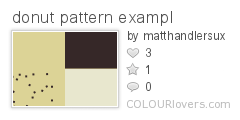Patterns are way easier to make than you may think, you just have to learn the tricks. That’s where I come in. It seems like the pattern world is real hush hush about their techniques and the tools out there are nothing short of awful – besides the COLOURlovers Seamless Pattern Maker and my own resources at madpattern.com. In this Educational Series I’ll be helping you understand the different types of patterns. Let’s first start with getting you Lovers up to speed on some of the universal laws of patterns.
Pattern Types

Pattern examples A, B, C, D (P1, P4, P6M, P3M1)
It is mathematically proven that there are only 17 different types of pattern symmetries. this is a surprisingly nice and natural way to organize the patterns you see around you.
Do you notice the symmetries?
Do you see how pattern A is just a bunch of images in a grid while pattern B is a motif rotated around its center four times?
Notice how pattern C has a naturally formed six-sided shape in it while pattern D has three naturally formed three-sided shapes.
Each of the 17-different types of patterns has a noticeable quality to it that you can learn to recognize. It actually takes a while to get good at, but it’s a pretty fun game you can play while walking around throughout your day. For more information about some of the mathematical background, I recommend you read this Wikipedia article on it called, Wallpaper Group.
Pattern by Type: P1
We are going to focus on the type of symmetry in pattern A, called P1. P1 is the mother of pattern styles because it is the easiest to understand. Over the next few months, I will be continuing these educational posts to encompass all of the 17-different pattern types.
That Repeating Square – The Cell
Every pattern has a square/parallelogram that becomes the repeating part (that’s the tile that you would make your desktop or website background). From here forward, this tile will be referred to as the Cell.

The biggest difference you’ll notice later in this Educational Series, is that P1 has only one cell, whereas other pattern types have a smaller unit that can be reflected/copied/rotated to generate the cell. P1 has the least amount of symmetry, which means that it distorts your original art the least. This makes it ideal for showing off your artwork clearly within a pattern repeat. It’ll be good to note here that the COLOURlovers seamless patterns are a P1, using the Cell for pattern repeats as seen in the Seamless Studio shot (above).

Getting to Know P1: Donut World

P1 is a donut!
Situation: Imagine you’re standing on top of a delicious gigantic frosted donut. You hear there are sprinkles on the other side and decide to walk around (this donut has gravity, so you wont fall off). Once you’ve gotten to the sprinkles you keep walking and you end up back where you started at frosting, yay! Weird though, to be stuck on this giant donut, it seems like as far as we walk in that direction, we will keep just seeing frosting, then sprinkles, then frosting again, etc. We’re trapped!
Here’s yet another situation you can walk yourself through: You’re standing on a vanilla frosted donut. Your buddy told you that the other half of the donut is chocolate glazed. Cool, lets go investigate. You walk around the top part of the donut and sure enough you find the chocolate frosting. Ok, so we head back around the donut, and now we are back at the vanilla side again. If we keep walking, we will continuously see vanilla, chocolate, vanilla, etc…
Ok, but what is the point? The point is that we have experienced a space that has this funny quality that no matter how far you walk in any direction, you’ll just keep seeing the same things over and over. Not a terrible situation considering we’re on a donut. The world of your donut, is the world of P1, and actually, when you look at normal p1 patterns printed out, what you’re really looking at is your donut world unfolded onto a plane.

donut world unfolded onto a plane
Notice if you’re standing on the chocolate glazed area and you walk vertically, you will pass into the vanilla frosted section, and then the chocolate section again and on and on. Same as the donut, but it looks very different, not as delicious.
The point of this exercise is to help you see that patterns are not just things you see on fabric and around the world, they are abstract spaces that have been unfolded onto a plane. So remember, when you look at patterns, you are really looking at an infinite world of wonder.

Hands-On Learning: Making Plaid (next time)
So ok, we’ve learned a little. Next time we will focus on understanding and creating a plaid. I’m going to show you how you can break down a pattern, and build it back up again from scratch. Stay tuned…